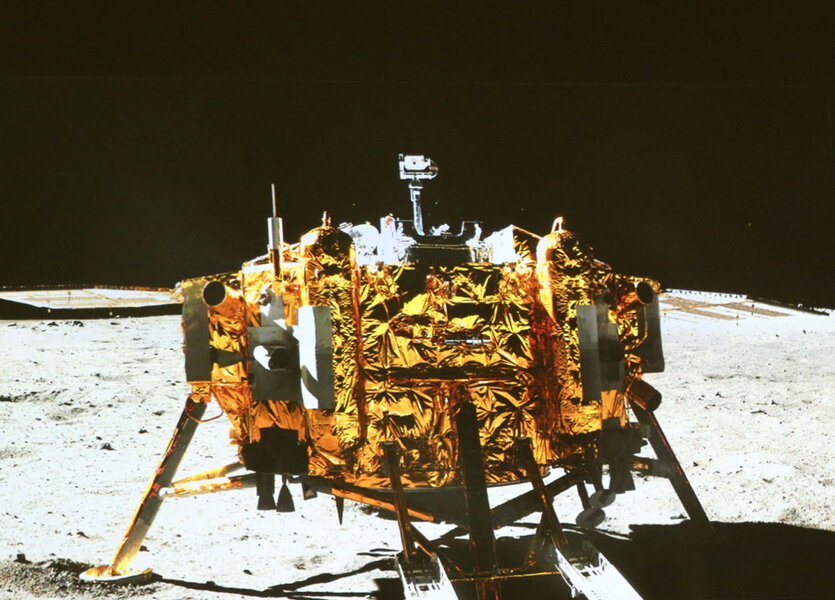China's Jade Rabbit lands on the moon, but will it play nice there?
China landed its rover, Jade Rabbit, on the moon over the weekend, becoming the third country to make a soft landing on lunar real estate and the first state to visit the lunar surface in almost 40 years. The landing, in highlighting both China’s technological capabilities and its lofty ambitions in the cosmos, now raises questions about what China will do next as it flexes its wings in the final frontier.
Chang’e-3, the lunar lander, and Jade Rabbit, its rover, landed on the moon’s Bay of Rainbows on Saturday, after about 13 days of space travel. State television showed the refrigerator-sized package – shiny and gold, like a wrapped candy – hovering over a blue plume as it beamed itself down. Back on Earth, China’s control room staff were shown applauding as the craft came to a gentle rest on the moon.
“Now as Jade Rabbit has made its touchdown on the moon surface, the whole world again marvels at China's remarkable space capabilities,” said Xinhua, China’s state news agency, in an article following the landing.
It’s been almost four decades since a state has made a soft landing on the moon (in a soft landing, the lander or rover alights intact on the ground). The last state to visit the lunar surface was the Soviet Union, in 1976. The US, the second country to make a soft moon landing, has not done so since 1972.
As the Soviet Union was leaving the moon for the last time, China’s space program was just a fledgling one, limited to satellite and missile development. Its space exploration program was nonexistent: the anxious, repeated attempts of Mao Zedong (who would die just a month later) to match the US and the Soviet Union in achievement and cobble together a crewed space program had disintegrated amidst political unrest. For years to follow, China was much too mired in economic duress to compete with spacefaring powers on the cosmic scale.
It was not until 2004, following China’s successful launch of a manned Earth orbiter, that the state announced its long-term series of lunar missions, all to be titled “Chang’e.” Chang'e, in Chinese myth, was an archer’s wife who swallowed a magic elixir that lifted her to the moon. She took with her a pet rabbit, "Yu Tu,” or Jade Rabbit. There, the pair has stayed, a lunar goddess and her rabbit.
It’s a romantic myth, and its dreamy tropes have burnished Chang’e lunar missions since the launch of the first mission, orbiter Chang’e-1, six years ago: “Flying to the moon is the nation's long cherished dream,” said Xinhua, after the launch of Chang’e-1.
Following Chang’e-3’s landing, China state media reiterated that the mission is a preamble to the state’s even grander, national ambitions, including a manned mission to Earth’s natural satellite and, in the long term, a trip to Mars. In the meantime, Chang’e-3, along with its companion “rabbit,” is charged with exploring a basaltic lava plain on the moon, as well as with setting up the first telescope there.
“It’s an impressive achievement,” says John M. Logsdon, a professor emeritus at George Washington University’s Space Policy Institute, of Chang’e-3. “With this mission, China is demonstrating a high level of space technology and operational capability.”
Though China is still decades behind the US and Russia in spacefaring capabilities, the state could “within 10-20 years be one of the top three space powers,” surpassing the European Union, Japan, and India, says Dr. Logsdon.
“It is close to that level now,” he says.
But while there is little doubt that China has developed advanced space technologies, there is some doubt if it will be “a responsible steward of space,” as it exercises its capabilities there, says Michael Krepon, director of South Asia and Space Security programs at The Stimson Center in Washington, D.C.
China, along with Russia and India, which recently launched a probe to Mars, has yet to endorse the European Union’s international code of conduct for the use of space. The code is designed to set standards for managing the congestion in Earth’s skies, in hopes of avoiding scenarios like the one in 2007, in which China, in a booming display of its missile might, shot down its own weather satellite and sent space debris coursing through the cosmos.
The latest version of the EU’s code, now in its third iteration, was released in September.
“We are still waiting to see how China will behave in global commons,” says Dr. Krepon. “Will China cooperate to protect the commons, or will it throw its weight around and act in a way that’s troubling to other stakeholders?”
"Space exploration is a common benefit for all human kind, but space weapons are a very different story," he says.
China and Russia have signed their own bilateral version of a code of conduct, but the document uses language that appears to exempt missile use from the ban on space weapons, says Krepon. The treaty, called the “Treaty on Prevention of the Placement of Weapons in Outer Space” (PPWT), was signed in 2008.
“Their treaty is not serious. The European Union code of conduct is serious,” he says. “China will need to decide whether it is serious about developing rules of the road in space.”
Under a 2011 law, NASA is banned from using its funds to collaborate with China on bilateral space activities. The US executive branch and state department, though, are not prohibited from engaging with Beijing, nor is NASA prohibited from engaging in multilateral collaboration with the Chinese space program.






